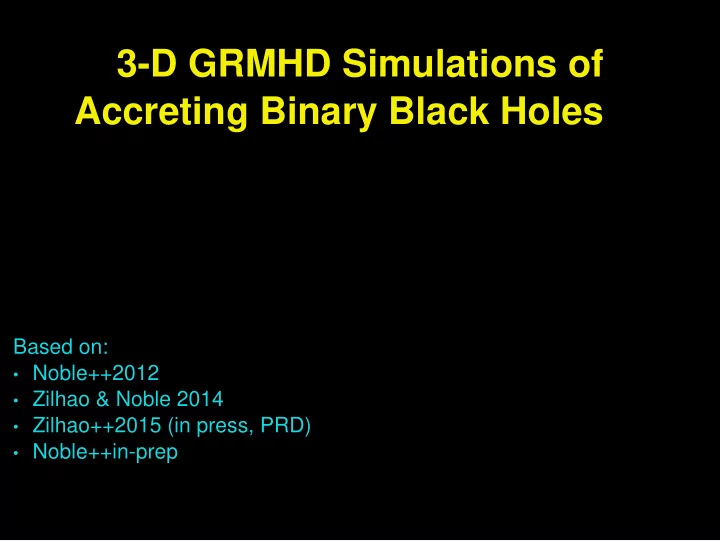

3-D GRMHD Simulations of Accreting Binary Black Holes Based on: • Noble++2012 • Zilhao & Noble 2014 • Zilhao++2015 (in press, PRD) • Noble++in-prep
Scott C. Noble (U. Tulsa)! [yes, that’s in Oklahoma] ! M. Campanelli (RIT)! D. Bowen (RIT)! J. Krolik (JHU) ! B. Mundim (Frankfurt U.)! H. Nakano (Kyoto U.)! M. Zilhao (Barcelona U.)! Y. Zlochower (RIT) Thanks to NSF PRAC OCI- 0725070 & NSF CDI AST- 1028087 “Black Holes in Dense Star Clusters” — Aspen — Winter — 2015 Motivation
+ Degeneracy ! Rare ! of ! Events Interpretations Better Models! +MHD More Data ! +3-d ( Pan-STARRS, +GR LSST, ZST, PST… ) +Radiation + Cooling
+Radiation Feedback Motivation • MHD turbulence = Ang. Mom. transporter;! • Field dissipation and growth cannot be modeled w/ 2-d hydro; • Vertical, 3-d structure can only include dynamics of Better Models! buoyancy;! • Cowling’s Thm: no sustained turbulence in 2 -d;
+ MHD + 3-d • Post-Newtonian (PN) accuracy required for binary separations below ~100M;! + GR • Necessary to self-consistently include binary inspiral from GW loss rate;! + Radiation Cooling • We know that significant mass can follow binary +Radiation Feedback through much of this period (Noble++2012); • Cooling required to regulate vertical thickness;! • Cooling provides a way to include more realistic thermodynamics consistent with its luminosity predictions; ! • No longer have to rely on L ~ Mdot ;! • Eventually radiation feedback important in regions of non- smooth optical depths (e.g., “gap”)
Galactic Merger Binary Inspiral FormationMerger Newtonian Gravity Eulerian, high- resolution/shockcapturing, 3-d, ideal MHD, Re-equilibration
Hopkins, Hernquist, Di Matteo, Springel++ Farris++2011 Noble++2012 dynamical GR, HLL fluxes, parabolic Static GR Post-Newtonian reconstruction, dynamical FMR Numerical Harm3d Harm3d Relativity Approximate Two Black Hole Spacetimes
Yunes++2006, Noble++2012, Mundim++2014 i i = m i / r i ⇤ ( v i / c ) 2 • Solve Einstein’s Equations approximately, perturbatively to orders of 2.5 Post-Newtonian order; • Used as initial data of Numerical Relativity simulations; • Black hole orbits include radiation-reaction terms; • BH event horizons are included! • Closed-form expressions allow us to discretize the spatial domain best for accurate matter solutions and is much simpler to implement;
• “Excise” BBH to afford O(100) orbits; ! • Simulation bank will be critical to initialize future inspiral studies w/ resolved BH’s; ! • Disk starts in “equilibrium”, threaded by poloidal magnetic field;
MHD Simulations with Unresolved BHs: Noble++2012
Accuracy of Gravity Model Zilhao++2015
• Turn off highest order PN terms in metric and use the “same” matter initial data; • Initial Data = Pressure+Rotation Equilibrium; • — > Disk = Disk(g ab ) • — > Disk(g ab [2PN]) != Disk(g ab [1PN]) • Use two strategies for 1PN disk: • Disk1: Use same orbital parameters as 2PN disk, though it has different H/R; • Disk2: Use different orbital parameters as 2PN disk, so that disk has same H/R;
Variabality vs. Post-Newtonian Accuracy: 1.5PN 1.5PN 2.5PN (Disk1) (Disk2) (Original) Less accurate metrics result in: Zilhao++2015
Variabality vs. Post-Newtonian Accuracy: • Fraction of accretion rate through “gap” is approximately the same; • All other runs we have done also show significant “leakage” rates; Apologies for mismatched scales! Less accurate metrics result in: Zilhao++2015
Variabality vs. Post-Newtonian Accuracy: • Stronger variability at lump’s orbital frequency; • Power at beat frequency spread to larger range of frequencies; • More complex lump/binary modulation; Zilhao++2015
Variabality vs. Post-Newtonian Accuracy: 1.5PN 1.5PN Top-down view of Surface Density 2.5PN (Disk1) (Disk2) (Original) Zilhao++2015
Variabality vs. Post-Newtonian Accuracy: Less accurate metrics result in: • Slightly weaker m=1 mode or over-density feature; • Likely explains the increased power at the binary’s orbital frequency; Zilhao++2015
Variabality vs. Post-Newtonian Accuracy: 1.5PN 1.5PN Side view of Beta = P gas / P mag 2.5PN (Disk1) (Disk2) (Original)
Less accurate metrics result in: Zilhao++2015 • Slightly less loss of magnetization; • Possibly due to weaker torque, less dissipation of field from flung out material; • Weak torques from “weaker” quadrupole potential; • Note thicker disk leads to less loss of magnetization; Mass Ratio Noble++in-prep q=1 q=2
q=5q=10 q=1 Mass Ratio Noble++in-prep q=2
q=5 q=10 Top-down view of Surface Density
Disk’s State Noble++in-prep • Bigger disk: • “Center” moved from 5a to ~6a; • Large extent increases reservoir of magnetic flux and mass; ! • Injected flux: • Magnetic flux from t=0 added late-time snapshot of original run;
Disk’s State Noble++in-prep Bigger Disk Original Flux-Injected • Increases local magnetic energy density by only a few percent; Again, please note different scales More magnetic flux led to: • Less coherent temporal power spectrum; • Spectra resembling more a slightly bent power law;
Disk’s State Noble++in-prep Bigger Disk Original Flux-Injected • Spectra resembling more spectra from simulations of single black hole disks; • Is there no over-density? More magnetic flux led to:
Disk’s State Noble++in-prep Bigger Disk Original Flux-Injected Top-down view of Surface Density • Much weaker m=1 mode, if any. • Therefore, no means of developing coherent beat; • Fluctuations arise just from turbulence;
Disk’s State Noble++in-prep Bigger Disk Original Flux-Injected Side view of Beta = P gas / P mag
Disk’s State Noble++in-prep Bigger Disk Original Flux-Injected • Injected flux led to sustained magnetization throughout over-density region; • Larger reservoir of flux and mass seems to hinder development of the lump;
Summary & Conclusions • Our 3-d MHD simulations in the PN-regime develop a high-Q signal that is non- trivially connected to the binary’s orbit; • We have unexpectedly seen how MHD dynamics can affect the quality of this signal and quash the development of the overdensity; • At a separation of 20M, with equal-mass binaries, differences in the metric at 1.5PN and 2.5PN orders are insignificant compared to stochastic error; • The PN-accuracy effects will likely be even smaller for smaller mass ratios;
• Overdensity and the “beat signal” disappear somewhere 2 < q < 5; • No coherent signal of any kind seen at q=10;
Recommend
More recommend